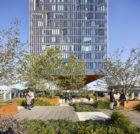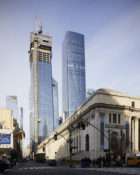SOM’s work in designing high-quality apartment living goes back to the 1950s, with the now-landmarked Manhattan House in New York City. Today, we consider the opportunity to create new rental residences—known in the industry as “build-to-rent”—as a framework for thinking about lifestyle and sense of place, and also a pathway for building vibrant cities through accessible housing options.
As our experience shows us, one size does not fit all. Careful consideration for lifestyle and cultural contexts and the existing neighborhood, as well as amenity, efficiency and aesthetics, are the cornerstones of success for these new communities. From Manhattan Loft Gardens’s new model for vertical community living in east London, to Lincoln Common’s relationship with the historic storefronts and legacy buildings of Chicago’s North Side, we’ve sought to respond to the distinctive qualities of each place. The strategies we’ve honed and the lessons we’ve learned from our work in North America and the U.K. can be tailored to local contexts around the world.
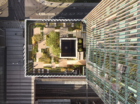
Building a vertical community
Manhattan Loft Gardens is situated alongside one of London’s largest and newest transport interchanges, Stratford International Station, which connects to local and regional rail lines. In creating the 42-story building, SOM’s team focused on the idea to create a vertical community that would promote social interaction and reflect the area’s diversity. With a mixture of residential loft-style and single-story apartments, a five-star hotel, and three sky gardens carved dramatically out of the building’s profile, Manhattan Loft Gardens represents a new, dynamic mixed-use model for high-rise living.
Its distinctive stacking produces an array of accommodations, including single studios, split-level lofts, and a three bedroom penthouse, to appeal to a diverse market. The striking, triple-height main entry lobby is shared between guests staying in the hotel on the lower levels and residents of the apartments, further fostering social interaction to cultivate an exciting living environment. With a uniquely engineered concrete and steel frame, the double-cantilevered tower accommodates three sky gardens in which residents can meet and interact. These gardens provide a variety of shared open-air spaces that offer spectacular views of the London skyline.

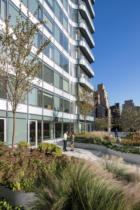
Luxury and community spaces come together
A shimmering addition to the New York City skyline, 252 East 57th Street is a 65-story tower in Midtown Manhattan with both rental and condo units. Along with the commercial retail space (including a grocery store) at street level, the redeveloped site includes two public schools. By locating school entrances on the quieter side streets while placing retail and residential entrances along 57th Street and 2nd Avenue, the site planning enlivens the streetscape, serves the community, and realizes the greater potential of a previously underdeveloped parcel. 252 East 57th Street’s residential program is organized with rental apartments on the lower floors and condominiums on the 36th floor and above—as a result, renters have access to the prestige and amenities associated with an exclusive Manhattan address. The experience of the tower begins with an elegant porte cochère, which gives residents a degree of privacy and security not often found in similar buildings. The sweeping views of the Manhattan skyline from the units above are complemented by SOM’s refined interior design of the living and amenity spaces.
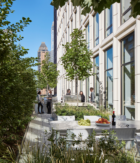

Sustainable design in a historic context
Situated in Manhattan’s Upper West Side, 15 West 61st Street has transformed a sought-after corner site on Broadway into a luxury residence that blends historic character, structure, and sustainability within one contemporary form. The building is distinguished by its modern masonry facade, which pays homage to the neighborhood’s material character. The self-shading facade enhances the building’s environmental performance, while an integrated micro-column structure allows for flexible, column-free interior layouts. Many units in 15 West 61st Street feature open-air loggias, which weave the outdoors into daily life and create outward-looking residences. The building’s range of amenities includes a large, communal terrace on the seventh floor, a fitness center, a game room, and a variety of lounges. At the crown, a communal triple-height loggia leads to a lounge area with panoramic views.
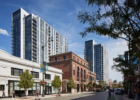

New neighborhood centers
Reflecting the vitality of the surrounding neighborhood, Chicago’s Lincoln Common incorporates a variety of building scales and architectural expressions to create a distinctive gathering place. It offers more than 68,000 square feet of open space, including the central plaza, landscaped gardens, and a children’s play area. The development includes retail space, two 20-story residential towers, condominiums, an office building, and the adaptive reuse of a turn-of-the-century brick building. Lincoln Common’s residential units and amenities don’t compromise when it comes to quality. Elegant and refined rental apartments are functional and efficient. Dynamic communal spaces, from the children’s garden and play area, to the public plaza, rooftop pool and grilling spaces, are complemented by the surrounding retail and dining options which enliven the historic streetscape.

All under one roof
Working with the City of Chicago, SOM designed Taylor Street Apartments and Little Italy Branch Library as one of the city’s first co-located Chicago Housing Authority and Public Library branches. The development includes a single-story public library branch and a multi-story mixed-income residential complex above, with additional community spaces at street level. Designed to create a synergy between the two distinct programs, the building has become a new hub for the neighborhood. The innovative approach and successful outcome led the Urban Land Institute’s Chicago chapter to honor the project with its 2019 Vision Award. It stands as an example of just one of the many ways a residential building can offer much more to its community.

